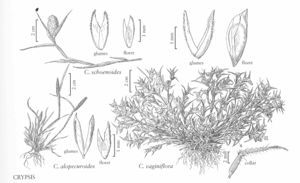Difference between revisions of "Crypsis schoenoides"
FNA>Volume Importer |
FNA>Volume Importer |
||
| Line 20: | Line 20: | ||
-->{{Treatment/Body | -->{{Treatment/Body | ||
|distribution=Ont.;N.J.;Mass.;Ohio;Utah;Calif.;Del.;Mich.;Wis.;Oreg.;N.Y.;Pa.;Ill.;Ind.;Iowa;Vt.;Ariz.;Mo.;Nev. | |distribution=Ont.;N.J.;Mass.;Ohio;Utah;Calif.;Del.;Mich.;Wis.;Oreg.;N.Y.;Pa.;Ill.;Ind.;Iowa;Vt.;Ariz.;Mo.;Nev. | ||
| − | |discussion=<p | + | |discussion=<p>Crypsis schoenoides is common to abundant in clay or sandy clay soils around drying lake margins and vernal pools. In the Flora region, it is most abundant in California, but also appears to be established in a few other western states. It is known from a few collections in several eastern states (where it was first introduced in the late 1800s), though apparently none more recently than 1955. Its native range extends from southern Europe and northern Africa through western Asia to India.</p> |
|tables= | |tables= | ||
|references= | |references= | ||
| Line 36: | Line 36: | ||
|basionyms= | |basionyms= | ||
|family=Poaceae | |family=Poaceae | ||
| + | |illustrator=Linda A. Vorobik and Karen Klitz | ||
|distribution=Ont.;N.J.;Mass.;Ohio;Utah;Calif.;Del.;Mich.;Wis.;Oreg.;N.Y.;Pa.;Ill.;Ind.;Iowa;Vt.;Ariz.;Mo.;Nev. | |distribution=Ont.;N.J.;Mass.;Ohio;Utah;Calif.;Del.;Mich.;Wis.;Oreg.;N.Y.;Pa.;Ill.;Ind.;Iowa;Vt.;Ariz.;Mo.;Nev. | ||
|reference=None | |reference=None | ||
| Line 41: | Line 42: | ||
|publication year= | |publication year= | ||
|special status= | |special status= | ||
| − | |source xml=https:// | + | |source xml=https://bibilujan@bitbucket.org/aafc-mbb/fna-data-curation.git/src/314eb390f968962f596ae85f506b4b3db8683b1b/coarse_grained_fna_xml/V25/V25_698.xml |
|subfamily=Poaceae subfam. Chloridoideae | |subfamily=Poaceae subfam. Chloridoideae | ||
|tribe=Poaceae tribe Cynodonteae | |tribe=Poaceae tribe Cynodonteae | ||
Revision as of 16:17, 30 October 2019
Culms 2-75 cm, prostrate to erect, sometimes geniculate, usually not branching above the base, but some plants profusely branched. Sheaths glabrous or ciliate at the throat, often inflated; collars glabrous; ligules 0.5-1 mm; blades 2-10 cm long, 2-6 mm wide, not disarticulating. Panicles 0.3-4(7.5) cm long, 5-6(15) mm wide, 1-5 times longer than wide, bases usually enclosed in the uppermost leaf sheaths at maturity. Spikelets 2.7-3.2 mm, tardily disarticulating. Lower glumes 1.8-2.3 mm; upper glumes 2.2-2.7 mm; lemmas 2.4-3 mm; paleas 2-veined; anthers 3, 0.7-1.1 mm. Caryopses about 1.3 mm. 2n = 32.
Distribution
Ont., N.J., Mass., Ohio, Utah, Calif., Del., Mich., Wis., Oreg., N.Y., Pa., Ill., Ind., Iowa, Vt., Ariz., Mo., Nev.
Discussion
Crypsis schoenoides is common to abundant in clay or sandy clay soils around drying lake margins and vernal pools. In the Flora region, it is most abundant in California, but also appears to be established in a few other western states. It is known from a few collections in several eastern states (where it was first introduced in the late 1800s), though apparently none more recently than 1955. Its native range extends from southern Europe and northern Africa through western Asia to India.
Selected References
None.
